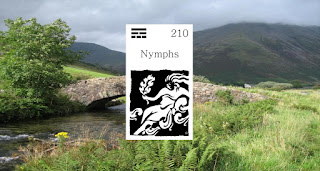Hag, the Initiator (Beginnings)
The hag initiates change and transformation, and signals the potential for significant change and transformation in relationships and the affairs of everyday life. Her often terrifying appearance is a test of your readiness for change.
Invoking Readiness for Change.
IF YOU ARE DRAWN TO THIS ORACLE, the hag may be testing your readiness for change. Her presence signals the potential for significant shifts in business and professional life, relationships, and the affairs of everyday living. New beginnings are possible. While the hag's outward appearance may be ghastly, welcoming her signals your readiness for a shift in awareness and fortunes. Anything may happen if you embrace such an unlikely stranger across the threshold of your life.
In Irish myth, a ghastly hag symbolizes the sovereign goddess of Ireland in the quest for the rightful heir and king. Through her, he is joined to the land. When the hag mates with the rightful heir, she signals his sovereignty by becoming a lovely maiden. In Irish and Scottish folk tales, the hag gives birth to the mountains and valleys, hills and rocks, and the various creatures of the land. The hag tests and initiates beginnings and rightful change.
The powerful hag is one of the three aspects of the Triple-Mother Goddess, the sovereign goddess of the land. Typically old and yet ageless, her terrifying appearance tests the readiness of kings and heroes. In Irish, Welsh, and Scottish legends, she enchants her "chosen" heroes with magical powers and confounds and hounds any who spurn her advances. Her shape is spine- tinglingly horrid and yet radiant, as captured in a contemporary poem, originally composed in Gaelic, by Nuala Ní Dhomhnaill:
"She stood naked in the dark, her palms cold like luminous fish on my shoulders:
her hips flashing fire beneath the two moons of her breasts.
I sank my head in her sea-weed hair and bitter waves of sea bruised and battered me, our white-horse waves rusted to rats: all became empurpled.
In the morning waking my head aching I saw sallow scales encrusted her and rotten teeth from the abyss snarled at me and hissed.
I took my awl and last and left the place fast!"
In approaching this goddess, the Irish kings were chosen. By legend, the reign of the U1 Neill, descendants of Niall, was initiated by the blessing of the goddess of sovereignty, the hag. Though the youngest of the five sons of the king, Niall became the king of Ireland from 379-405. As the story is told in an early fifth-century manuscript, Niall and his four brothers were out hunting in the forest and were overwhelmed by thirst. One by one, each brother comes upon a pool of water guarded by a hideous hag. She offers each a drink in exchange for a kiss and each one flees at her dreadful appearance, except for Niall. He kisses the crone and makes love to her. As they kiss, the hag becomes the loveliest of maidens, her face like the radiance of the sun - none other than the goddess of sovereignty herself.
Folk tales in Ireland, Wales, and Scotland abound in stories about the hag, the "Mountain Mother," the "Great Old One," or the Cailleach in Gaelic. Striding across the land, she "lets fall from her skirts" the natural features and creatures of the land. In Ireland, many tales tell of benevolent hags, loathsome hags, hags saved by saints from peril, and hags who turn to hares and turn back into an old neighbour woman again when caught milking the cows!
Life presents many situations that are unsettling, even abhorrent. When troubles arise, they may represent the presence of the hag, artfully disguised. There is no way to prepare for her, except to watch for her presence. She has come to test your nerve and willingness for living in a new way. Welcoming her many manifestations signals a ready and awakened consciousness. Having crossed the threshold of danger, many things - anything - is possible.




